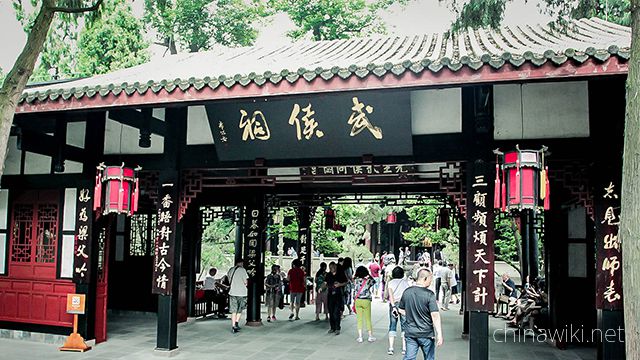Ankang Temple
Ankang Temple
The former Ankang temple, also known as the Anchang courtyard, is located on the South Bank of the temple bridge in the old street of Anchang. The temple is magnificent and magnificent. It is a great view of the nearby area. In the 1930s and 1950s, it was destroyed because of the return of salary and demolition. Thanks to the prosperity of the times, all kinds of industries are flourishing. Zen people invested 60 million yuan to rebuild the original site, covering an area of 32 mu, with a construction area of more than 9200 square meters. The fine carvings on camphor wood are all in place, and the opening of Buddha's eyes is just around the corner.
Ankang Temple
Controversy on the beginning of Ankang Temple
According to the records of Shaoxing Buddhism and the materials of Shaoxing temple, there are two versions about the beginning of Ankang Temple: one is built before Kaiyuan of Tang Dynasty, and the other is built in the first year of Changxing of Tang Dynasty after the Five Dynasties. Both of them span a period of two centuries. In order to respect history and prevent the later generations from being delayed, it is necessary to study them carefully.
Historical basis of Ankang Temple
It was built in the Tang Dynasty
According to the annals of Shaoxing Prefecture of Kangxi (12th year), "an Chang Yuan, Tang sun ti's" Li Qiu RI Ti ti an Chang Si Bei Ting "
Louguan, leaning on Changxiao, ascended to Jichao. As high as the top of the stone gate, it is better than the red city mark. The sky is close to the clouds and the rainbow. The mountain is surrounded by Boyu temple, and the river is behind xuchao. It's thin in summer and autumn, and the cool wind is floating on the sun. Only bitter plum is in the fruit forest, and sweet banana is covered with water. You can see the past and love the sky. Even more heard the golden brake, bell chime night Xiao Xiao
Most of the chronicles of the song, Ming and Qing Dynasties clearly record the date of the founding. Only the chronicles of the Kangxi government do not record the date, but only the poem "Li Qiu RI ti an Chang Si Bei Ting". Therefore, later generations speculate that Ankang temple was built before Kaiyuan (713) of Tang Dynasty by sun Tiyou, a poet in Kaiyuan period of Tang Dynasty, who wrote the poem of Beiting.
Built in the late Tang Dynasty
According to Jiatai Kuaiji annals (the first year), "Ankang Hospital was built 93 Li northwest of the county in the first year of Changxing in the later Tang Dynasty.".
In the annals of Shanyin County of Jiajing (30 years), it is recorded that Ankang temple is 55 Li northwest of the county, and the place name of Qingfeng township is Anchang. In the first year of Changxing in the later Tang Dynasty, monk Anpu built the temple, named Anchang courtyard.
"Shanyin county annals of Kangxi" (ten years) records: "the reconstruction of monk Fancheng in the early years of Shunzhi".
According to the records of Shaoxing Prefecture of Qianlong (57th year), "Ankang temple is called Anchang temple, Jiatai temple is 93 Li northwest of the county, which was built in the first year of Changxing in the later Tang Dynasty. Shanyin is located 55 Li north of the county. The name of Qingfeng township is Anchang. In the first year of Changxing of Tang Dynasty, the monk anpujian was named anchangyuan. In the early years of Shunzhi, the monk Fancheng was rebuilt. Tang sunti's poem on the North Pavilion of Anchang temple in autumn (brief).
According to the annals of Shanyin County of Jiaqing (8th year), "Ankang temple is 55 Li northwest of the county. It is named Anchang in Qingfeng township. In the first year of Changxing of Tang Dynasty, it was built by an Pu, a monk, and named Anchang courtyard. It was rebuilt by an fan Cheng, a monk at the beginning of the country. (an Anchang Jiatai, a member of the old Zhian temple, records 93 Li to the northwest)
Address: Xunyang County, Ankang City
Longitude: 120.49142427116
Latitude: 30.135847141382
Chinese PinYin : An Kang Si
Ankang Temple
-
Sun Yatsen Memorial Hall
Sun Yatsen Memorial Hall. Zhong Shan Ji Nian Tang
Views: 52 Time 2021-02-25 -
Qiaowan city site in Jiuquan
Qiaowan city site in Jiuquan. Jiu Quan Qiao Wan Cheng Yi Zhi
Views: 57 Time 2021-02-26 -
Hegang National Mine Park
Hegang National Mine Park. He Gang Guo Jia Kuang Shan Gong Yuan
Views: 54 Time 2021-02-27 -
Memorial hall to resist US aggression and aid Korea
Memorial hall to resist US aggression and aid Korea. Kang Mei Yuan Chao Ji Nian Guan
Views: 51 Time 2021-03-01

